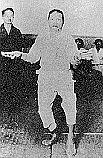
KENWA MABUNI
( - )
Kenwa Mabuni was born in Shuri, Okinawa in 1889. Kenwa Mabuni was a 17th generation descendant of the Okinawan warrior class whose ancestors served the Okinawan lords for hundreds of years. In 1902 at the age of 13, he began his martial arts instruction under Yasutsune Itosu in the village of Shuri.
In 1909 he also began to study Naha-te under Kanryo Higaonna, who was introduced to him by a childhood friend, Miyagi Chogun. These men were the highest authorities of karate at that time, and were the founders of two schools of Okinawan Karate, Shorin-Ryu and Shorei-Ryu. Both these instructors passed away when Mabuni was in his late 20's.
Mabuni Sensei was the ichiban-deshi of
Itosu Sensei, suceeding him as the second master of Itosu-Kai. He continued his studies after the death of these great masters, becoming adept at traditional Okinawan weaponry while also incorporating elements of Chinese Kung Fu into his style. Mabuni's insatiable thirst for knowledge prompted him to develop an extensive body of karate information. The defining characteristics of Sensei Mabuni's karate was its large number of kata, the versatility of its fighting techniques and the inclusion of Okinawan weapons in its instruction.
Mabuni Sensei had an insatiable appetite for kata, studying with masters such as Arakaki Kamadeunchu (1840-1918) of Naha from whom he learned the Unshu, Nisheishi, Sochin, Arakaki-sai and Arakaki-bo katas.

Arakaki Kamadeunchu
(1840-1918)
He was also being influenced by a Fukien, 'White-Crane-Fist' master named WU XIAN GUI (pronounced GO KENKI in Japanese) at the time.

WU XIAN GUI
(Kenwa Mabuni in background at left)
Upon hearing of master Itosu's death in 1915, Kenwa Mabuni was so upset that legend indicates he built a shrine in front of master Itosu's grave and looked after the gravemarker. He would come to the grave site and diligently practice his kata daily, for over a year, to pay respect and honour to the great master.
In 1929, after compulsory military service and a career as a police officer, Mabuni Sensei left Okinawa for Osaka, Japan to teach Itosu-kai. The Japanese government's martial arts sanctioning organization, the Dai Nippon Butoku-Kai began to demand the different groups applying for membership, be more specific in the description of their Karate systems, and pressured them to name their systems. Kenwa Mabuni originally named his system 'HANKO RYU' (Half-Hard style), but, later changed it using the alternative reading of the Kanji for 'ITO' from master ITOSU's name, (which can also be read as 'SHI' ), and 'HIGA' from master HIGAONNA's name, (which can be interpreted as 'TO' ), Kenwa Mabuni created the new name, 'SHITO' for his style of Karatedo.
In this way, he chose to honour and respect his great teachers.
Because of his contribution to Japanese culture and society, Kenwa Mabuni was bestowed by the emperor the family crest (mon) of the circle with four bars. This was a great honor as no other family could claim the use of this symbol. When the Kanji for Shito-Ryu is placed within the mon, the symbol for the historical lineage of Shito-Ryu karate is formed. This symbol represents the pure, unaltered tradition of the Nippon Seito Shito Ryu Kai.

Kenwa Mabuni only issued five Shihan Menjo in his life and died on May 23, 1952, leaving no direct successor to his lineage.
When he died, Mabuni had two of three sons survive him, Kenei and Kenzo (no information on the third son.) Mabuni Kenei had long left the family and lived in Tokyo where, although he had no formal karate training with his father, had established the Shito Kai with Iwata Manzo (one of the five to receive a Shihan Menjo from Mabuni Kenwa.)
Mabuni Kenzo had begun his karate training with his father at the age of 14 and continued diligently until his father's death in 1952. After his father's death, it was his mother that came to Mabuni Kenzo and requested that he take over the style. Mabuni Kenzo could not decide at that time and went into seclusion for two years to contemplate this great responsibility. He decided to accept this responsibility and is the inheritor of his father's lineage.
From that time, Mabuni Kenzo dedicated his life to preserving the true lineage of his father's karate. He was not concerned politics or image and remained unknown to the outside world while his older brother and others were spreading their influence in the name of Shito-Ryu Karate. In 1993, upon the request of his good friend Ozawa, Mabuni Kenzo traveled to Las Vegas and and exposed the world to Seito (pure) Shito-Ryu, the true karate of his father, Mabuni Kenwa.
In April of 1994, Mabuni Kenzo conducted seminars in Albany, New York and Phoenix, Arizona. Subsequent to these seminars, Mabuni Kenzo established the Shito-Ryu Karate Do Kai of America comprised of dojos that had requested of him consideration as his direct students and received formal acceptance by his senior instructors, the Nippon Karate Do Kai Shihan Kai.
When Kaiso Hisataka was young, there were many leading Okinawan Karateka who would get together and discuss and practice Karatedo. According to Masayoshi Kukan Hisataka, he mentions in his book " Essential Shorinjiryu Karatedo ", that Master Kenwa Mabuni was recognized as Kata expert, and was among those who Kaiso Hisataka had the opporunity to engage in exchange training with.
|

